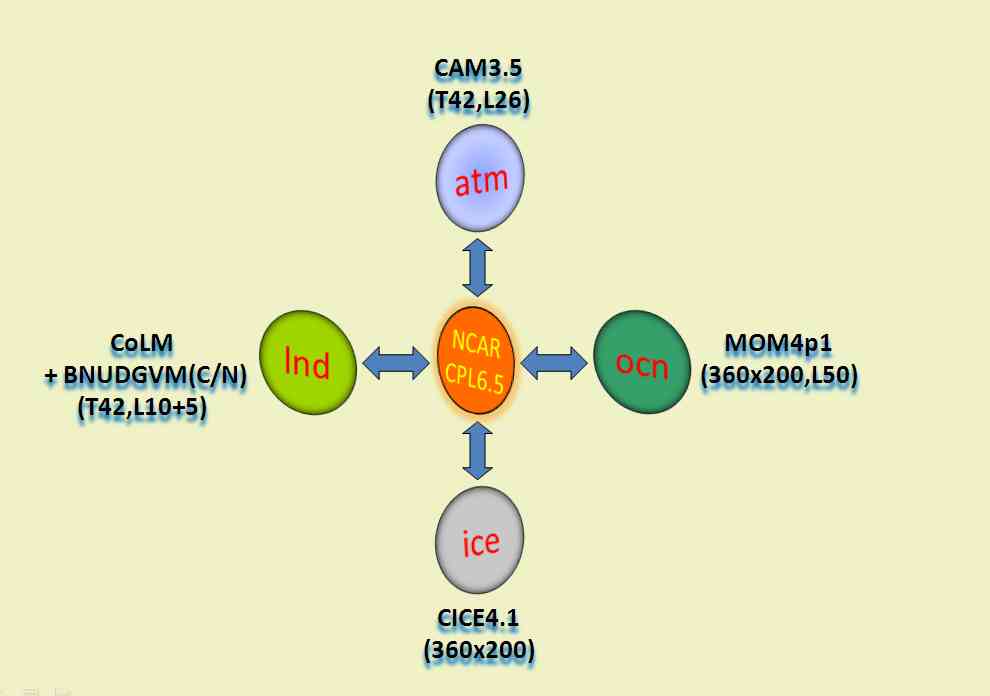John Moore - Glaciology and Paleoclimate
Main projects at present are:
-
Geoengineering: Integrated approaches and impacts, China Global Change Program (973 Project), National Basic Research Program of China #2015CB953602 2015-2019
-
ICECAP2: International Collaborative Exploration of Central East Antarctica through Airborne geophysical Profiling. Global Innovation Initiative, British Council, plus national funding (USA, UK, India, China)
-
Simulating Antarctic marine ice sheet stability and multi-century contributions to sea level rise Finnish Academy 2015-2019
Several projects have been related to Earth System Modeling using the BNU-ESM:
 SEAP-CMIP5, SuperEnsemble Projection and Attribution of Climate Change based on CMIP5, National Key Science Program for Global Change Research (member of science committee), No. 2010CB950504-02, 2010-2014
SEAP-CMIP5, SuperEnsemble Projection and Attribution of Climate Change based on CMIP5, National Key Science Program for Global Change Research (member of science committee), No. 2010CB950504-02, 2010-2014
Topics relate to glaciological modeling
Stability and Variations of Arctic Land Ice (SVALI), Nordic Centre of Excellence, 2011-2016
Kinnvika - you can read a
blog
from our spring 2007 expedition and several papers from a special issue of Geografiska Annaler:
Beaudon, et al 2011 Spatial and temporal variability of precipitation volume
from shallow cores from Vestfonna ice cap (Nordaustlandet, Svalbard).
Pohjola,et al , 2011 Spatial distribution and change in the surface ice-velocity field of Vestfonna ice cap, Nordaustlandet, Svalbard, 1995-2010 using geodetic and satellite interferometry data.
Pohjola, et al. Editorial - The International Polar Year project "KINNVIKA" - Actic warming and impact research at 80N,
and this earlier paper Beaudon, E. and J.C. Moore, 2009 Frost flower chemical signature in winter snow on Vestfonna ice cap (Nordaustlandet, Svalbard), The Cryosphere 3, 147-154
Antarctic blue ice area paleoclimate - you can read a
blog
from our 2006/7 expedition
Aslak grinsted completed his PhD thesis
just before travelling to Antarctica in November 2006 on advanced methods of time series modelling
Anna Sinisalo defended her thesis on November 16 2007 on geophysical exploration of Antarctic blue ice areas
The main question my group and I try to address are:
-
How are glaciers in Svalbard and Antarctica behaving now
- What do ice cores from Svalbard and Antarctic tell us about climate history
- What will changing climate do to glaciers in the polar regions
The tools we use to answer these questions are:
- Ice core chemical analysis to extract past climate information
- Ground penetrating radar studies of glaciers to study their internal structure
- Mathematical modelling and analysis of the climate records and glacier evolution
Projects described by area
Field work in Svalbard
Questions to be addressed in our Svalbard reearch are:
- What is the climate history preserved in ice core records
- What is the detailed structure of Svalbard glaciers<
- How have the glaciers changed over the last century
Photos from the 2001 campagn on Lomonosovfonna
are available. This was primarily a radar and pit sampling shor trip,
and our summer student Kristiina Virkkunen took part in, and will do detailed
chemsitry of the winter snow on the summit as her "project" work for her
Master's degree.
Two of my PhD students are primarily working on Svalbard glaciology:
Anja
Pälli
is studying the radar properties of polythermal glaciers,
particularly the hydrothermal internal structure; Teija Kekonen is a chemist working on the Lomonosovfonna ice core from Svalbard.
The Polish Polar Station in Hornsund, southern
Svalbard (t
his is the external link
to the Polish site
), where Anja Pälli and
I
were
doing ground penetrating radar studies of Hansbreen with the
Malå
Geoscience
Ramac radar 50 MHz antennas and
with higher resolution
200 MHz antennas.
We also profiled numerous other smaller glaciers in the region such as
Tuvbreen.
The radar was very good in general, though of course there were
repairs
that
need doing as well - with always excellent help from the Poles, especially
Piotr Glowacki, and always with time for a nice beer with our
gallant
leader
.
In 1999 Anja and I together with Jacek Jania (University of Silesia)
and Piotr Glowacki (Polish Academy of Sciences) began a program to study
changes in glaciers over a 100 year period in Svalbard. The fieldwork
was interesting, and some pictures by the Poles
are
here.
Antarctica
Questions to be addressed in our Antarctic reearch are:
- Can we extract climate data from surface blue ice
- How does the climate information compare with that from deep ice cores
Modelling
Questions to be addressed in our modelling reearch are:
-
Can we see underlying dynamics of the climate system in ice cores and other proxy records
- How do the climate dynamics change over time
- Can we use radar techniques and surface ice flow
- How will a radar perform in mapping the inernal structure of the moon Europa
Europa Orbiter Ice Penetrating Radar - I have been really fortunate enough
to have been involved in the preliminary study of using a radar to measure
the ice thickness of crust of the Jovian moon Europa,
here is the abstract of a paper in Icarus on
modelling the ice properties. This has led to the production of an
Announcement of Opportunity
(currently a draft version) which invites interested persons to submit proposals to the future
NASA Europa orbiter
space mission.
 SEAP-CMIP5, SuperEnsemble Projection and Attribution of Climate Change based on CMIP5, National Key Science Program for Global Change Research (member of science committee), No. 2010CB950504-02, 2010-2014
SEAP-CMIP5, SuperEnsemble Projection and Attribution of Climate Change based on CMIP5, National Key Science Program for Global Change Research (member of science committee), No. 2010CB950504-02, 2010-2014